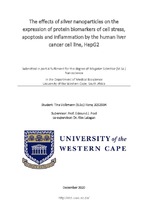| dc.contributor.advisor | Pool, Edmund J. | |
| dc.contributor.author | Volkmann, Tina | |
| dc.date.accessioned | 2021-09-06T11:56:32Z | |
| dc.date.available | 2021-09-06T11:56:32Z | |
| dc.date.issued | 2021 | |
| dc.identifier.uri | http://hdl.handle.net/11394/8429 | |
| dc.description | >Magister Scientiae - MSc | en_US |
| dc.description.abstract | Nanoscience is the study of phenomena and objects at the nanoscale (around 1-100 nm), socalled
nanomaterials. These nanomaterials exhibit novel properties that are often very
different to those of the bulk materials used for their synthesis. Hence, nanoparticles are
widely commercialised, especially silver nanoparticles (AgNPs) due to their antimicrobial
properties and some other useful phenomena. This commercialisation leads to inevitable
exposure to the environment and humans, which leads to inhalation, ingestion or dermal
uptake of AgNPs by the human body culminating in distribution to several major organs,
including the liver. Both chronic and acute exposure to AgNPs have been linked to detrimental
effects in both in vitro and in vivo studies. These include oxidative stress, induction of
inflammation, DNA damage, cell death and many others. | en_US |
| dc.language.iso | en | en_US |
| dc.publisher | University of Western Cape | en_US |
| dc.subject | Silver nanoparticles | en_US |
| dc.subject | Protein | en_US |
| dc.subject | Human liver cancer | en_US |
| dc.subject | Oxidative stress | en_US |
| dc.subject | Cell stress | en_US |
| dc.title | The effects of silver nanoparticles on the expression of protein biomarkers of cell stress, apoptosis and inflammation by the human liver cancer cell line, HepG2 | en_US |
| dc.rights.holder | University of Western Cape | en_US |

